The geology and paleontology of the Caldecott Tunnel's Fourth Bore
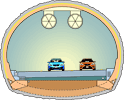
III. The fossils associated with the Caldecott Tunnel
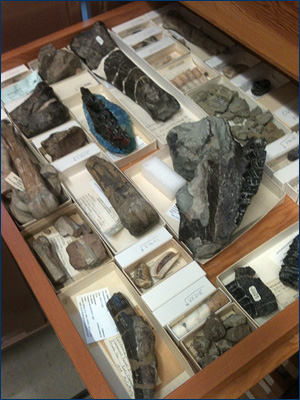
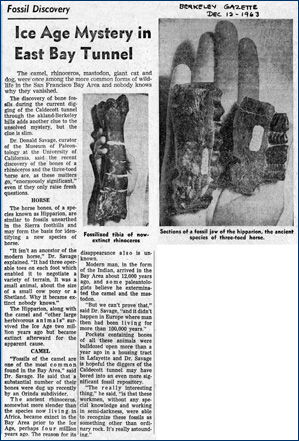
Top: A drawer in the UCMP collections full of vertebrate fossils recovered from past Caldecott tunnel excavations. Photo by Dave Smith. Bottom: Click on the image to see an enlargement. A 1963 Berkeley Gazette article about bones found during construction of the Third Bore. The bones pictured can be identified in the top photo. Article from the UCMP archives.
These days there are a variety of federal, state, and local laws and regulations that pertain to the identification, evaluation, and recovery of paleontological resources at construction sites.1 That has not always been the case. Caltrans spokesman Jeff Weiss said "When they dug the first and second bores the workers back then — although they weren't required by law — just out of the goodness of their heart they were finding fossils and turning them into the foreman, who would turn them over to UC Berkeley."2 See some of those fossils in the photo at right.

Click on the image to see an enlargement. A 1963 Oakland Tribune article on fossils found near the Third Bore's eastern portal. Article from the UCMP archives.
To be in compliance with the current laws and regulations for the Fourth Bore project, Caltrans contracted with PaleoResource Consultants of Auburn, California, to collect and prepare any fossil material that might be (and was) encountered; UCMP was designated as the fossil repository. Since the Fourth Bore was being excavated from both ends simultaneously, PaleoResource had field paleontologists stationed at both the east and west portals. In the early going, monitors had access to the fresh rock faces at the portals where the in situ fossils were the best specimens recovered from the project; however, once actual tunneling began, the monitors were restricted to looking through the excavated rubble (spoils) that was scooped up by front-end loaders, dropped into mining dump trucks, and off-loaded outside the portals. Inspecting the fresh rock face at the end of each excavation round was not possible because of safety concerns; it would be too dangerous for anyone to be close to the face with unsupported ground overhead. Monitors had to work fast and salvage what they could from the spoils piles before the rubble was hauled away. Certainly not an ideal arrangement, but a sufficient quantity and variety of fossils were recovered to add to the body of knowledge regarding the ecology of the East Bay during Miocene times. Fossils were found both at the portals and within the rocks of the tunnel. Among the three rock units, the Orinda Formation was the most fossiliferous.
About halfway through tunnel construction, PaleoResource's contract expired and Caltrans arranged to have Garcia and Associates of San Anselmo, California, continue with the monitoring and collection of fossils. To address preparation, Caltrans approached UCMP Associate Director of Collections and Research Mark Goodwin. As Goodwin explained it, "A master agreement exists between the California Department of Transportation and UC Berkeley. They came to us, discussions proceeded, and I drafted a one-year agreement and budget in collaboration with my colleague at Caltrans. The contract was awarded to UCMP for preparation, curation, data management, and other activities we could provide based on our paleo-expertise."3 At the time, the museum was without a preparator, but in the contract, Caltrans agreed to provide the funds needed to hire a prep lab manager for one year. This individual would manage the prep lab and supervise grad and undergrad students in fossil preparation and curation. Funds were also provided for equipment, tech support, and the development of this web feature.
The microfossils
Graduate Student Researcher (GSR) Susan Tremblay looked for microfossils, specifically foraminifera and ostracodes (a class of tiny crustaceans), in rock samples collected from all three formations. To get a good look at them, it was necessary to separate them from their rock matrices. Since the shells of ostracodes and many foraminifera are calcium carbonate, and those of other foraminifera are grains agglutinated with an organic lining or cement, acids could not be used to break down the rocks because the fossils would dissolve in the process. Susan came up with a successful method of isolating the microfossils in the shales and sandstones of the Claremont Formation; you can read about the process in her blog. The microfossil yield from the Claremont samples consisted of the tests (shells) of foraminifera and fragments of coalified plants.
Foraminifera (foram) tests occur in marine sediments dating back as far as the Cambrian; their high diversity, abundance, and evolution make them useful in determining the relative ages of rocks. They are also important in reconstructing paleoenvironments. For example, the composition of foram assemblages helps determine the paleoenvironment of deposition and the analysis of oxygen isotopes in the tests can be used to establish water temperatures. Forams are sensitive to food availability, as well as salinity and temperature variations, so they are excellent indicators of environmental change.
Ken Finger, UCMP's Senior Museum Scientist in charge of the museum's microfossil collections, identified the three most common foram taxa in the Claremont Formation as Martinottiella communis, Pyramidulina acuminata, and Lenticulina sp. Today this benthic (bottom-dwelling) association occurs on the continental slope, no shallower than 500 meters, suggesting that the waters were quite deep at the time of deposition. The cherts of the Claremont Formation were formed almost entirely from the frustules (cell walls made of silica) of diatoms (a group of single-celled algae), however, they are difficult to process because "… the diatom silica has dissolved and recrystallized, forming a very dense microcrystalline rock."4
Susan's microfossil-separation process did not work so well for the rocks of the Sobrante Formation — they proved to be much more resistant to breaking down. Susan experimented with other methods but without success. A few forams were visible on the surface of some rock fragments but identification to genus was not possible.
Although the sediments of the Orinda Formation were of terrestrial origin, Susan applied her process to the Orinda samples hoping to recover some freshwater ostracodes, but the laboratory processing yielded only a few charcoal fragments.5
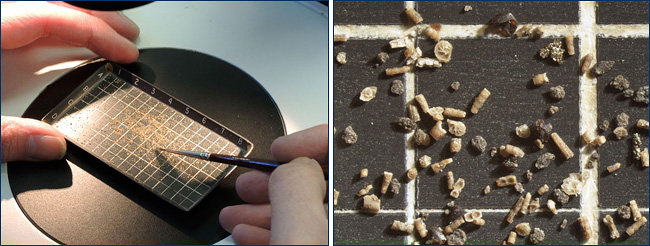
These images of microfossils (mostly foraminifera) from the Claremont Formation provide a sense of their size. Each square in the grid is about 4 mm wide. Photos by Susan Tremblay and Tom Madsen.

A snail fossil from the Sobrante Formation, one of the rare invertebrates that was found in one piece. Photo by Ashley Poust.
The invertebrates
Aside from some bivalve shell fragments and a single bivalve shell mold from the Claremont Formation, all invertebrate fossils (not counting microfossils) found during the Fourth Bore excavation came from the Sobrante Formation; none, not even freshwater molluscs, were found in the Orinda Formation. Most of the recovered fossils were in a fragmentary condition. These included bivalves, gastropods, scaphopods (Dentalium), and arthropods. Their presence supports the interpretation that sediments from the Sobrante Formation accumulated on a continental shelf.
The plants
More than 200 fossil plant specimens from the Caldecott's Fourth Bore have been recorded in the UCMP database. A few leaves, stems, and some charcoal5 were found in the marine Sobrante Formation — perhaps these were washed in from the mainland and buried — but the vast majority (198) of the plant fossils were from the Orinda Formation. Prior to the Fourth Bore project, "Orinda flora" was just a name on a page in a now classic 1964 article by Evernden & James6. In that publication, they provided radiometric age-dates for many plant-bearing beds throughout the western United States that presumably contained fossil "floras." However, at the time of their writing, the "Orinda flora" was really non-existent — no one had yet collected any plant fossils from the formation and the floral name had never appeared in the paleobotanical literature7. Now, thanks to the Fourth Bore project, we have a bona fide Orinda flora, and thanks to Evernden & James, we know its age.
Although the Orinda leaves are not that well preserved, a number have been assigned to genus; with further study more taxa may come to light. The taxa that could be identified should look familiar to Bay Area residents because they grow here, as well as in other parts of the state, today. Some of the fossil species are very similar to California "native" species such as Umbellularia (California bay laurel), Salix (willow), Quercus (oak), Platanus (sycamore), and Betula (birch). Others like Ulmus (elm) and Persea (evergreens belonging to the laurel family, e.g., avocado), however, are not considered "natives"8 according to our present-day anthropomorphic view, but clearly they were an integral part of the regional flora in Miocene "California." In addition, the Orinda Formation rock samples provide an opportunity for the possible recovery of fossil pollen and spores (palynomorphs), which could reveal much more about East Bay plant diversity in the Middle to Late Miocene, especially for the herbaceous plants. The leaves of herbaceous and ground cover plants are not often preserved as megafossils, therefore, they are not well known or well-represented in fossil floras.
About 16 miles (as the crow flies) east-southeast of the Caldecott Tunnel's east portal is the Black Hawk Ranch Quarry. The fossils found at this historic locality are also Miocene in age, but are perhaps a few hundred thousand years younger (9.0 to 9.7 Myr9) than the Orinda Formation. What is unusual about the rocks from the Orinda Formation and the Black Hawk Ranch Quarry is that both vertebrate and plant fossils are preserved. Normally, a depositional environment will favor preservation of one or the other, but not both. However, having both kinds of fossils is valuable in that you can see what herbivores were present and get a good idea of what they were eating.
Of the 200 fossil leaf specimens collected at the Black Hawk Ranch Quarry in the late 1930s-early 1940s, 195 of them were identified as being from poplar, elm, willow and sycamore.10 The remaining five leaves were from mountain mahogany, sumac and two species of oak. Using modern floral communities for comparison, paleobotanist Daniel Axelrod (B.A., M.A., and Ph.D. from UC Berkeley) reasoned that the dominant assemblage represented a floodplain community receiving a moderate amount of rainfall, including summer rain — Axelrod put annual rainfall at about 25 inches. The mountain mahogany, sumac, and oaks were probably from a woodland-chaparral community that existed some distance away.
The leaf fossils from the Orinda Formation also suggest a floodplain community, which is in accord with the geology. And given their somewhat battered condition, the leaves probably underwent some transport before being buried; this too is in keeping with the geology. The presence of Persea, which is not particularly drought tolerant, may indicate that rainfall was a bit higher than at Black Hawk Ranch or perhaps the area benefited from coastal fog; Persea is also not frost tolerant so the area must have had mild winters.

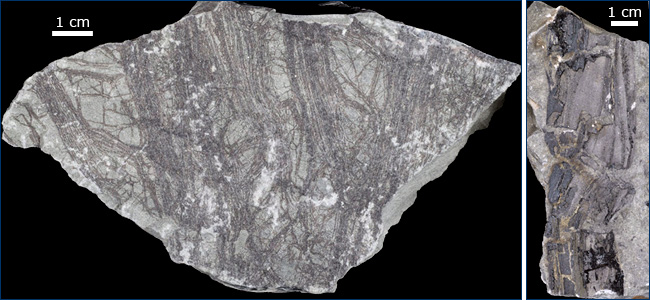
Top: Persea (UCMP 201051, left) and Quercus (UCMP 201185, right) leaves from the Orinda Formation. Bottom: Filamentous algal strands (UCMP 201200, left) and a Magnoliopsida stem (UCMP 201209, right) found in the Sobrante Formation near the Fourth Bore's west portal. All photos by Robert A. Stevenson.
The biggest difference between the East Bay's Miocene climate and today's is the change from year-round rainfall to the current Mediterranean climate: wet winters and dry summers. This change actually began just a little later in the Miocene due to "cooling of deep seas and upwelling of ever-colder water along the Pacific coast."11 The causes of the cooling and upwelling can ultimately be traced to plate tectonics — see Minnich 2007 (pp. 43-70) for a complete explanation. It is interesting to note that the annual rainfall for the city of Orinda today is about 27 inches — close to Axelrod's estimated annual rainfall for Black Hawk Ranch — but between December and March, the city averages 4.8 inches of rain per month, and between June and September, a mere 0.1 inches.12
Plants have often taken a back seat to vertebrates in artists' reconstructions of the East Bay Miocene environment. The first reconstructions, based on the fossils recovered from the Black Hawk Ranch Quarry, were visualized by artist William Gordon Huff in the late 1930s. Looking at Huff's restorations, one might think that the landscape was a barren plain with only the occasional tree cropping up here and there. But one can't really blame Huff — he was recreating the scene as envisioned by Charles Camp and Ruben Stirton, two of UCMP's vertebrate paleontologists who were certainly more interested in the animal life. In actuality, the plant fossils from both Black Hawk Ranch and the Orinda Formation support the idea that the landscape was quite heavily wooded. As Diane Erwin, UCMP's Senior Museum Scientist in charge of the paleobotanical collections, put it, "… those browsers and grazers needed to be eating something."13 Compare one of Huff's interpretations (below, top) to a more modern, and accurate, depiction (below, bottom).
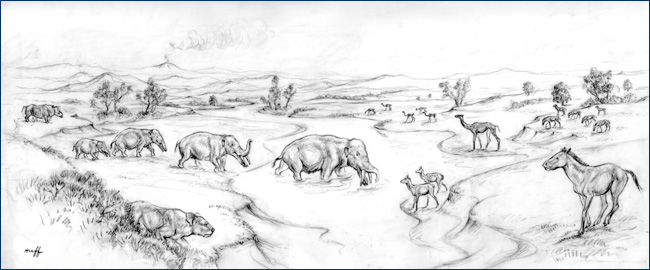
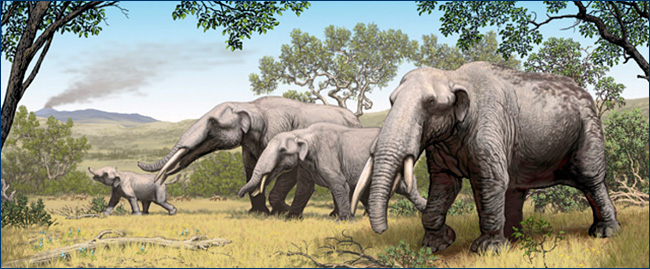
Top: One of William Gordon Huff's drawings of an East Bay Miocene landscape, based on fossils recovered from the Black Hawk Ranch Quarry. Bottom: Artist Carl Buell's interpretation of the same landscape. Both images feature a herd of elephant-like gomphotheres. Huff drawing from the UCMP archives; Buell illustration used with permission.
The vertebrates
Vertebrate fossils recovered during excavation of the first three bores of the Caldecott Tunnel all came from the Orinda Formation. Those in the UCMP database include teeth from the early horses Hipparion and Nannippus, teeth from the horned artiodactyl Cranioceras, a distal tibia from the early rhinoceros Aphelops, a tooth from Barbourofelis (similar to the saber-toothed cats), a partial skull with teeth of the early camel Procamelus, other camelid bones and teeth, and a Cetotheriidae (a family of baleen whales) vertebra. Since the rocks of the Orinda Formation were terrestrially deposited, this last specimen may have been reworked from older marine deposits.
In the excavation of the Fourth Bore, an additional 35 vertebrate specimens were recovered from the Orinda Formation, some of them new to the list of known Orinda animals. Only two specimens, a rodent dentary and a turtle plastron, could be identified to genus (Copemys and Hesperotestudo, respectively); still, many could be identified to family. Bones of rhinos, oreodonts, horses, camels, rodents, turtles, tortoises, and even fish (freshwater we assume) have been found.
So far, there is only one entry in the database recording the presence of vertebrates in the marine Claremont Formation: fish scales. However, GSR Ashley Poust reports that the Claremont yielded two bones from marine mammals that have not yet been cataloged.
Over 200 vertebrate specimens from the marine Sobrante Formation — primarily fish bones, scales, teeth (shark), and "fish hash" — have been cataloged and are in the database.
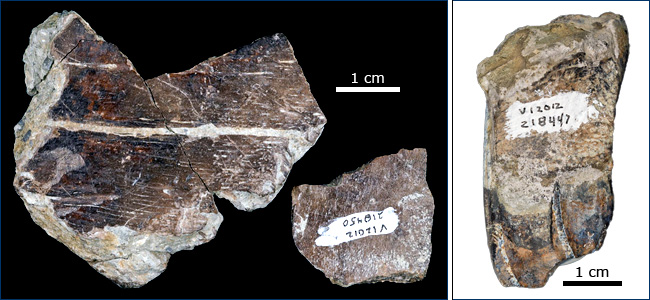
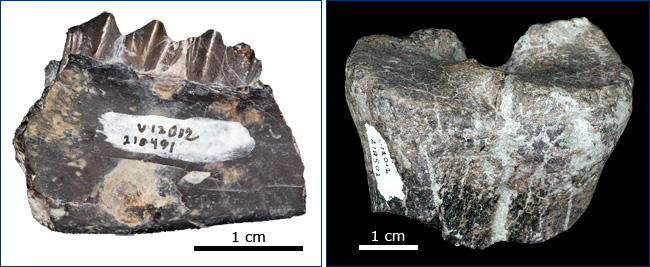
Some of the vertebrate specimens found in the Orinda Formation during excavation of the Fourth Bore. Top left: Fragments of turtle carapace (UCMP 218450). Top right: A tooth (M/3) from an early horse (UCMP 218447). Bottom left: A partial dentary from an artiodactyl (UCMP 218447). Bottom right: A fragment of a camelid metapodial (UCMP 218502). All photos by Robert A. Stevenson.
In summary
At the start of the Fourth Bore project, all the fossils in the UCMP collections that came from the earlier Caldecott Tunnel bores were vertebrates. Because paleontologists were on site looking for all kinds of fossils, the museum now has an assortment of microfossils, invertebrates, and plants, not to mention bones representing new vertebrates. Of course, the museum does have some fossils from the Sobrante (invertebrates), Claremont (forams), and Orinda (ostracodes, gastropods, bivalves, mammals) formations collected from other East Bay localities, but the Fourth Bore additions definitely have increased our knowledge of the biotic diversity in the area during the Middle and Late Miocene.
The Caltrans-UCMP contract was a boon for UCMP; the museum vastly increased its collections of East Bay Hills fossils and received the resources necessary to prepare and catalog them. In providing those resources, Caltrans demonstrated that it appreciates the importance of California's fossils, and, since people are continually fascinated by fossils, it received a good deal of media coverage and good publicity as a result. There is no question that the deal was a win-win for both parties and UCMP looks forward to more such collaborations in the future.
Below is a table of the Fourth Bore fossils that have been cataloged to date (11/25/13). More material remains to be processed and cataloged so the number of specimens — and perhaps the kinds of organisms represented — are sure to increase.
Fourth Bore fossils in the UCMP database
| UCMP locality number | Number of specimens | Locality name | Fossils by formation | ||
|---|---|---|---|---|---|
| Plants | Sobrante | Claremont | Orinda | ||
| PA1308 | 1 | Caldecott Tunnel I - RW 2E | vascular plant stem | ||
| PA1309 | 186 | Caldecott Tunnel II - RW 2E | vascular plant leaves, stems, pollen; Lauraceae leaves; Liliopsida leaves; Persea, Umbellularia, Salix, and Quercus leaves | ||
| PA1310 | 7 | Caldecott Tunnel III - RW 2E | Magnoliopsida leaves; Platanus, Quercus, Betula leaves | ||
| PA1311 | 1 | Caldecott Tunnel IV - RW 2E | vascular plant stem | ||
| PA1312 | 1 | Caldecott Tunnel V - RW 2E | vascular plant stem | ||
| PA1313 | 2 | Caldecott Tunnel VI - RW 2E General | vascular plant charcoal; Ulmus leaf | ||
| PA1315 | 16 | Caldecott Tunnel VIII - Sobrante General | vascular plant stems, coalified stems, charcoal; Liliopsida stem and leaf | ||
| PA1316 | 3 | Caldecott Tunnel IX - West Portal General | filamentous algal strands; Liliopsida stem and leaf; Magnoliopsida stem | ||
| Invertebrates | |||||
| IP13002 | 1 | Caldecott 4th Bore Claremont General | bivalve shell mold | ||
| IP13003 | 58 | Caldecott 4th Bore Sobrante first shale | Foraminifera; gastropod shells and fragments (some associated w/fish fossils); Dentalium shell fragments (associated w/fish fossils); bivalve shells and fragments (associated w/fish fossils, fish scales, vertebrate rib fossils); Heterodonta shells; micro-sized molluscs; Arthropoda fragments (including crustaceans) | ||
| IP13004 | 1 | Caldecott 4th Bore Sobrante portal sandstone | bivalve shell fragments | ||
| IP13005 | 3 | Caldecott 4th Bore Sobrante shaly sandstone | bivalve shells; gastropod shell | ||
| IP13007 | 1 | Caldecott 4th Bore Claremont second sandstone | bivalve shell fragments | ||
| Vertebrates | |||||
| V12003 | 7 | Caldecott 4th Bore Sobrante General | shark teeth; Actinopterygii bones, scales, vertebra impression | ||
| V12004 | 1 | Caldecott 4th Bore Claremont General | Actinopterygii scales | ||
| V12005 | 194 | Caldecott Tunnel 4th Bore Sobrante first shale | shark teeth and possible scale; Osteichthyes bone; Testudines fragment; Actinopterygii bones and scales, fish hash, vertebra w/partial neural spine, fish skeleton w/articulated vertebrae (some associated w/mollusc shells, charcoal, echinoderm spines) | ||
| V12012 | 35 | Caldecott Tunnel 4th Bore Orinda General | Chordata bone fragments; Actinopterygii bone; Chelonia eggshell, carapace fragment; Testudinidae carapace fragment; Hesperotestudo plastron; Reptilia bone fragments; Mammalia tooth and bone fragments, partial scapula, limb bone and fragments, cervical vertebra fragment, carpal/tarsal fragments, two vertebrae, one proximal rib; Rodentia tooth; Copemys right dentary; Artiodactyla metapodial/metatarsal, right dentary, tooth fragment; Camelidae metapodial fragment, partial vertebra, left proximal tibia; Equidae partial sacral vertebra, distal metapodial fragment, right metatarsal; Hiparionini tooth; Merycoidodontidae incisor, partial maxilla; Rhinocerotidae femur | ||
1 To find out more about these laws and regulations, see the section on Paleontology in the online Standard Environmental Reference (SER). The SER is a "resource to help state and local agency staff plan, prepare, submit, and evaluate documents for transportation projects." [from the SER home page]
2 From this KTVU news story (accessed 10/29/2013).
3 Personal communication, July 12, 2013.
4 Ken Finger, personal communication, Nov. 25, 2013.
5 The presence of charcoal in the Sobrante and Orinda Formations suggests that the coastal area was prone to periodic fires.
6 Evernden, J.F., and G.T. James. 1964. Potassium-argon dates and the Tertiary floras of North America. American Journal of Science 262:945-974.
7 Wolfe, J.A. 1981. A chronologic framework for Cenozoic megafossil floras of northwestern North America and its relation to marine geochronology. Geological Society of America Special Paper 184. Pp. 39-47.
8 Calfora: http://www.calflora.org/
9 Prothero, D.R., and R.H. Tedford. 2000. Magnetic stratigraphy of the type Montediablan Stage (Late Miocene), Black Hawk Ranch, Contra Costa County, California: Implications for regional correlations. PaleoBios 20(3):1-10.
10 Axelrod, D.I. 1944. The Black Hawk Ranch flora. In R.W. Chaney (ed.), Pliocene Floras of California and Oregon. Carnegie Institution of Washington Publications 553:91-101.
11 Minnich, R.A. 2007. Climate, paleoclimate, and paleovegetation. Pp. 43-70 in M.G. Barbour, T. Keeler-Wolf, and A.A. Schoenherr (eds.), Terrestrial Vegetation of California. University of California Press. 712 pp.
12 From http://www.weather.com/weather/wxclimatology/monthly/graph/USCA0813 [accessed Nov. 20, 2013].
13 Personal communication, Nov. 20, 2013.